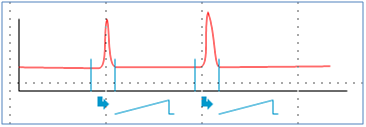Heart-cutting 2D-LC
In heart-cutting 2D-LC (also known as LC-LC), only parts of the eluent from the first dimension are injected into the second dimension using a switching valve and at least one sample loop. The gradient analysis in the second dimension can be longer than the sampling time, but in the case of single-loop sampling must be shorter than the interval between first-dimension samples.
The volume of sample to be injected on to the second dimension is defined either by a peak trigger or by a time window. When heart cutting starts, the loop is switched into the flow path of the first dimension, and switched back either when the peak ends or at the end of the time window. The second dimension analysis starts when sampling is complete.
Time-based heart cutting
In time-based heart cutting, specific sampling time windows are set up; only the eluent from the first dimension in the specified time windows is injected and analyzed in the second dimension:

Peak-triggered heart cutting
In peak-triggered heart cutting, only peaks that exceed a specified threshold level are sampled in the first dimension and injected and analyzed in the second dimension:
